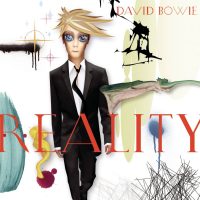 Recorded: January-May 2003
Recorded: January-May 2003
Producers: David Bowie, Tony Visconti
Released: 15 September 2003
Personnel
David Bowie: vocals, guitar, keyboards, saxophone, Stylophone, synthesizers, percussion
Earl Slick, Gerry Leonard, David Torn: guitar
Mark Plati: guitar, bass guitar
Tony Visconti: guitar, bass guitar, keyboards, backing vocals
Mike Garson: piano
Gail Ann Dorsey, Catherine Russell: backing vocals
Sterling Campbell, Matt Chamberlain: drums
Mario J McNulty: drums, percussion
Tracklisting
Contents
- ‘New Killer Star’
- ‘Pablo Picasso’
- ‘Never Get Old’
- ‘The Loneliest Guy’
- ‘Looking For Water’
- ‘She’ll Drive The Big Car’
- ‘Days’
- ‘Fall Dog Bombs The Moon’
- ‘Try Some, Buy Some’
- ‘Reality’
- ‘Bring Me The Disco King’
Reality was David Bowie’s 25th solo studio album, including his soundtrack works. It was recorded and released in the wake of Bowie’s Heathen album and tour, and was his last album before his 10-year hiatus from recording.
I feel that reality has become an abstract for so many people over the last 20 years. Things that they regarded as truths seem to have just melted away, and it’s almost as if we’re thinking post-philosophically now. There’s nothing to rely on any more. No knowledge, only interpretation of those facts that we seem to be inundated with on a daily basis. Knowledge seems to have been left behind and there’s a sense that we are adrift at sea. There’s nothing more to hold onto, and of course political circumstances just push that boat further out.
Sound On Sound, October 2003
The album was the second since Bowie’s reunion with Tony Visconti. The pair had worked together to great effect on Heathen, and were keen to resume their working relationship.
We weren’t even tentative when we went in to do Heathen. We kind of knew that we would produce something really excellent. We didn’t know quite what it was going to be, but it just kind of fired our motors, I think. And we charged into Reality absolutely gung-ho about doing what we used to do, which is produce a signature sound and an interesting construct that would sound quite not like anybody else’s work. It would be identifiably kind of a Bowie/Visconti production, and it would just have that special thing that we have when we work together. I can’t really articulate it, but when we work together, we do seem to produce really good quality stuff that has a sense of integrity, and is interesting. It’s just right, and it’s very exciting.
Steinway.com
In addition to his artistic renaissance, Bowie was enjoying the partnership his label ISO had forged with Columbia, which allowed him to release new music at his own pace. Bowie had expressed frustration with the typical delay between release cycles and promotional campaigns.
These days, it’s great to be able to record more frequently and clear the decks of the songs I’m writing. For me, this is a far preferable way to go, and it does resemble the way that I’ve worked in the past. I had a spate of being able to do that in the early ’90s, and I would have liked to work Outside and Earthling against each other a lot faster, but at the time we had a major problem even finding somebody to put Outside out, because it was such an odd album. In the ’70s, I think I probably over-achieved – I was doing two to three albums a year, co-writing with Iggy and putting my own albums out. It was insane. Some years I put out two albums, but there was consistently at least one album a year, and I think I find an album a year very comfortable. It doesn’t faze me at all, and it tends to follow the pattern and the rhythm at which I write.It’s kind of cathartic, and Columbia are pretty cool about it, so it’s great. They said they would agree to this when I first took my ISO label to them – I said, ‘Look, I will require that I can put out stuff when I want to, and I don’t want to have one of those sell-through dates inflicted on me,’ which is what you usually get: ‘Oh, we’ve got another 18 months until you can do that.’ They’ve been great so far, and when I hit them with a new album they’re ready for it.
Sound On Sound, October 2003
Coming off the back of the Heathen tour, Reality deployed the majority of Bowie’s live musicians. The new album was tighter, less experimental, with an urban immediacy inspired by the surroundings of its creation, New York City.
Throughout Heathen and Reality he was in such a good place. On the road he had such a blast, smiling all the day, I’d never seen him happier. We had a good run for about four years straight.
David Bowie: A Life, Dylan Jones

The cover art is more good than bad. Overall impression is very positive. LP does work so much better than CD art wise.